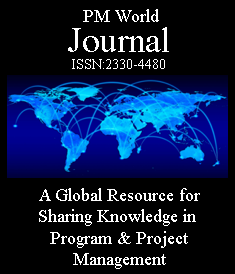through Standardized Multidimensional WBS:
A Bidding Template Approach for EPC Project
FEATURED PAPER
By Alvin Murad Rachmadsyah
Balikpapan, Indonesia
ABSTRACT
This study explores ways to strengthen project management practices in Amine Regeneration Unit (ARU) projects at a National Oil and Gas Company, particularly in addressing recurring cost and schedule overruns. The research centers on creating a standardized format for a multidimensional Work Breakdown Structure (WBS) and bidding template, designed to capture the essential project information needed for accurate and project-specific bids. A comparative method was applied, benchmarking the company’s existing practices against the U.S. National Park Service’s Construction Class A Cost Estimate Template. The approach involved formulating a structured WBS and examining the bidding process to design a more uniform and efficient framework. Findings indicate that adopting a standardized bidding template integrated with a detailed WBS can enhance project execution, reduce the risk of cost overruns, improve resource allocation, and foster clearer alignment of project requirements between Contractors and the Company. In addition, this framework is expected to serve as a foundation for database automation, strengthening front-end loading. Sustained improvements through performance monitoring and the establishment of KPIs will be essential to ensure long-term success.
Keywords: Standardized, Multidimensional WBS, OmniClass Table, Refinery Expansion, Amine Regeneration Unit, hydrogen sulfide (H2S), Database Automation, Artificial Intelligence, National Oil and Gas Company
INTRODUCTION
- Amine Regeneration Unit for Refinery Expansion and Grassroots Refinery Development in Indonesia
Indonesia has played an essential role in the global oil and gas sector for decades. In the past, the country was not only a major producer but also a significant exporter of crude oil and natural gas, with the industry serving as one of the key drivers of national economic growth. However, in recent years, Indonesia’s oil and gas sector has faced the Energy Trilemma [1] challenges, three pillars associated with the country’s macroeconomic situation in terms of economic development: energy security, energy equity, and sustainability [2]. Indonesia is carefully managing the energy trilemma to maintain economic development, with the current decline of oil production to approximately 650,000 barrels of oil per day (BOPD) and an increase in domestic consumption up to approximately 1,5 million BOPD. This shift has altered Indonesia’s position in the global energy market, shifting the country from being a net oil exporter to a net importer. To address this challenge while aligning with its net-zero emission commitments, Indonesia is now prioritizing investments in green refinery expansion and the development of new grassroots refineries.
One of the primary challenges in refinery project design and development is managing Hydrogen Sulfide (H₂S). This gas is colorless, flammable, and highly toxic, and it commonly occurs in refinery operations. During the conversion of crude oil into products such as gasoline, diesel, and lubricants, impurities like H₂S are often generated. In addition, H₂S is typically present in off-gases from various process units. If released into the atmosphere, these sour gases can emit significant amounts of H₂S, creating serious risks for worker safety, equipment integrity, and the surrounding environment. Effective management of H₂S is therefore critical to maintaining safe and sustainable refinery operations.
Developing an Amine Regeneration Unit capable of absorbing and eliminating the risk of these off-gases is a mandatory requirement. The Amine Regeneration Unit will be required to strip H2S and CO2 from the Rich Amine with a Stripper. Sour Gas will be routed to the Sulphur Plant, while product amines (Lean Amine) will be recirculated to each process unit. Topsoe, as one of the technology providers, describes the process of ARU as follows:
More…
To read entire paper, click here
Editor’s note: This paper was originally prepared during a 6-month long Graduate-Level Competency Development/Capacity Building Program developed by PT Mitrata Citragraha and led by Dr. Paul D. Giammalvo to prepare candidates for AACE CCP or other Certifications. https://build-project-management-competency.com/our-faqs/
How to cite this paper: Rachmadsyah, AMR (2025). Refinery Project Database Automation through Standardized Multidimensional WBS: A Bidding Template Approach for EPC Project; PM World Journal, Vol. XIV, Issue XI, November. Available online at https://pmworldlibrary.net/wp-content/uploads/2025/11/pmwj158-Nov2025-Rachmadsyah-project-database-automation-bidding-template.pdf
About the Author

Alvin Murad Rachmadsyah
Balikpapan, Indonesia
![]()
Alvin Murad Rachmadsyah is a Project Engineer with seven (7) years (since 2017 – Present) of professional experience in the oil and gas refinery and petrochemical development project. He holds a bachelor’s degree in physics engineering from the Sepuluh Nopember Institute of Technology (ITS). Currently, he works as a Project Engineer at Indonesia’s National Oil Company. He has been involved in several projects in the oil and gas sector, such as refinery expansion, ammonia plant reactivation projects, workshops & warehouses, pipelines, storage tanks, jetties, and other downstream projects. He is attending a distance learning mentoring course under the tutelage of Dr. Paul D. Giammalvo, CDT, CCE, MScPM, MRICS, GPM-m, Senior Technical Advisor at PT Mitrata Citragraha, to attain Certified Cost Professional (CCP) certification from AACE International.
Alvin lives in Balikpapan, Indonesia and can be contacted at alvin.murad@gmail.com.
[1] World Energy Council. (2024). World Energy Trilemma 2024: Evolving with resilience and justice. Retrieved from https://www.worldenergy.org/publications/entry/world-energy-trilemma-report-2024
[2] Marti, L. & Puertes, R. (2022). Sustainable energy development analysis: Energy Trilemma. Retrieved from https://www.sciencedirect.com/science/article/pii/S2773032822000074









